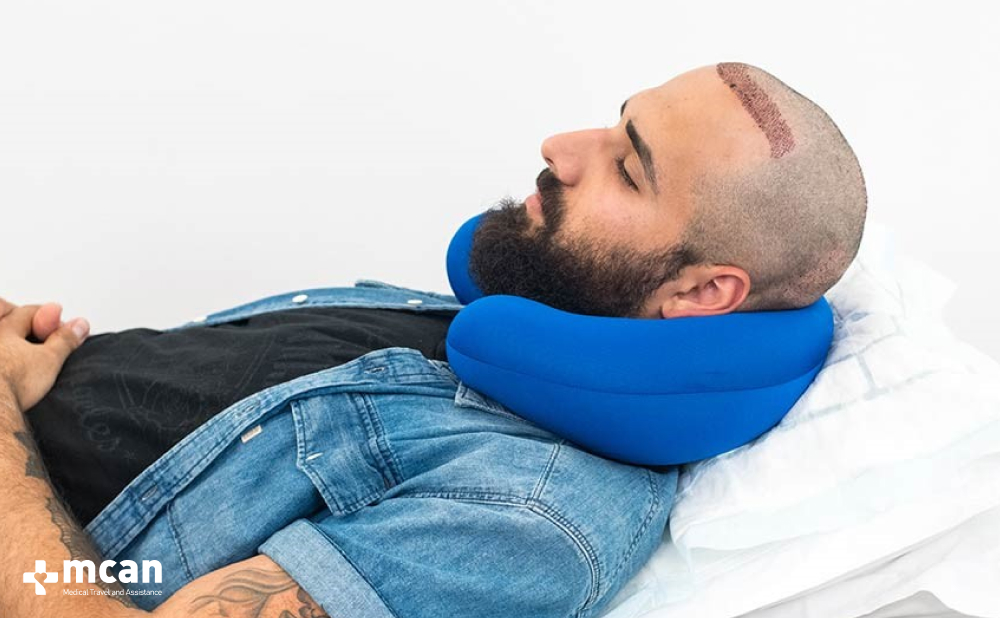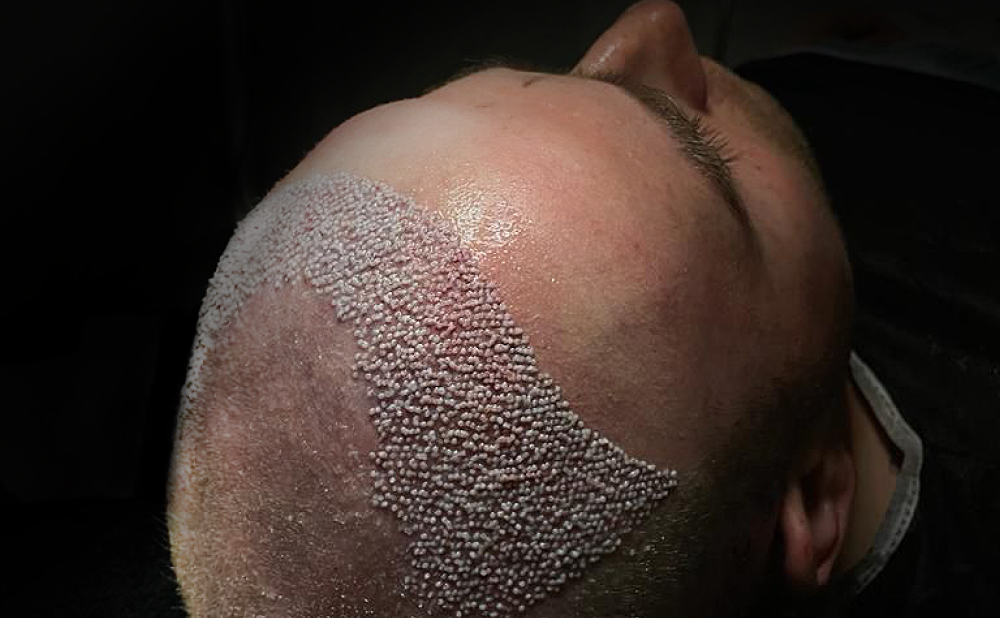
After a hair transplant, the way you sleep is more than just a comfort issue, it directly affects the healing of your scalp and the long-term success of your results. In the first few nights especially, newly implanted grafts are at their most vulnerable, and small mistakes in sleeping posture or hygiene can undo the progress of your procedure.
Learning about how to sleep safely after a hair transplant is crucial for avoiding unnecessary pressure, reducing swelling, and giving the grafts the stability they need to survive. From sleeping positions to head elevation, even minor adjustments can make a major difference in how well your scalp recovers.
In this article, we’ll walk you through each step of the post-transplant sleeping process, including when to elevate your head, how long to avoid sleeping on your side, and what changes you can make to your routine to avoid dislodging or damaging grafts.
Why Sleep Position Matters After Hair Transplant
In the first days following a hair transplant, your scalp is in a healing phase, and the newly implanted grafts are not yet firmly secured. How you sleep during this period plays a key role in protecting those grafts and ensuring optimal recovery. Sleeping with your head elevated helps drain excess fluid and reduces puffiness. To learn more about how swelling develops and what to expect in the first days post-op, see our guide: Hair Transplant Swelling: Causes and Care Tips.
Key reasons your sleep position matters are:
- Preventing dislodged grafts: Direct contact between your pillow and the transplanted area can cause friction or pressure that may loosen or dislodge grafts before they’ve settled.
- Reducing swelling: Post-operative swelling is common, especially on the forehead and around the eyes. Sleeping with your head elevated helps drain excess fluid and reduces puffiness.
- Minimizing infection risk: Keeping your head elevated and away from unclean surfaces decreases the chance of introducing bacteria to healing areas.
- Improving blood circulation: A stable sleeping posture supports healthy blood flow to the scalp, which is essential for healing and early graft survival.

When Can You Sleep Normally After a Hair Transplant?
Sleeping may seem like the simplest part of your routine, but after a hair transplant, it becomes a crucial part of protecting your grafts and supporting early healing. The position you sleep in and the surfaces your scalp comes into contact with can significantly impact the outcome of your procedure, especially in the first 7 to 10 days.
In this period, the transplanted grafts are still settling and can be disturbed by pressure, friction, or improper posture. Knowing how to sleep safely at each stage of recovery helps reduce swelling, prevent complications, and give the grafts the stability they need to survive. For a broader view of the entire recovery process, visit our post on Hair Transplant Timeline: A Guide to Hair Transplant Recovery & Growth Chart.
How to Sleep on Days 1–3 After Hair Transplant
This is the most delicate phase of recovery. Grafts are freshly implanted and can be easily dislodged, so you’ll need to follow strict sleeping precautions:
- Sleep on your back only, keeping all contact away from the transplanted area
- Keep your head elevated at a 30–45 degree angle using pillows or a recliner
- Use a travel or neck pillow to reduce movement and prevent turning in your sleep
- Avoid sleeping on soft surfaces that cause you to sink or shift
How to Sleep on Days 4–7 After Hair Transplant
By this stage, the grafts begin to anchor, but your scalp is still healing and requires care:
- Continue sleeping on your back, with your head elevated
- Avoid pressure from bedding, headrests, or turning your head during the night
- Stay consistent with your pillow setup to maintain alignment
- Wash your pillowcases frequently to reduce the risk of irritation or infection
How to Sleep After One Week
After the first week, grafts are generally secure, and you may begin easing back into normal sleeping habits but only with medical confirmation:
- If scabbing has completed and your clinic gives approval, you can slowly return to side sleeping
- Avoid sleeping face down or applying direct pressure to treated areas
- Consider using a soft, clean head covering or pillow protector to stay cautious during the transition
- Continue monitoring for sensitivity, tightness, or swelling before fully resuming your usual sleep routine
Best Sleeping Positions After Hair Transplant
Proper sleeping posture after a hair transplant is essential to protect the grafts, reduce swelling, and support smooth healing. For the first 7–10 days, even small amounts of pressure or friction during sleep can affect results, so it’s important to choose your sleeping position carefully.
Recommended Sleeping Positions
| Position | Why It Works |
|---|---|
| On your back with head elevated | Keeps pressure off the grafts, supports blood flow, and helps reduce swelling |
| In a recliner chair | Naturally maintains a 30–45° angle and prevents rolling or shifting during sleep |
| With a neck or travel pillow | Keeps your head stable and minimizes unintentional movement |
Sleeping Positions to Avoid
| Position | Why to Avoid It |
|---|---|
| On your side | May cause indirect pressure on the scalp or donor area |
| On your stomach | Applies direct pressure to transplanted grafts, increasing risk of dislodging |
| Leaning on cushions/headboards | Friction or sliding may disturb the healing grafts, especially on the crown |
How to Elevate Your Head While Sleeping

In the first few days after a hair transplant, keeping your head elevated while you sleep is essential. Elevation helps reduce swelling, protects the newly implanted grafts, and supports healthy healing by improving circulation and limiting contact with pillows or bedding.
Here are some effective ways to elevate your head safely and comfortably:
- Stack 2–3 firm pillows to raise your head and upper body at a 30–45° angle
- Use a wedge pillow designed for post-surgical recovery to maintain a steady incline
- Sleep in a recliner, which naturally holds your upper body upright and minimizes movement
- Place a neck or travel pillow around your neck to prevent turning and keep your head stable
- Use extra pillows along your sides to prevent rolling over while you sleep
- Avoid soft, deep pillows or surfaces that allow your head to sink or tilt to one side
Though this sleep setup may take some getting used to, maintaining proper elevation for the first 5–7 nights plays a major role in graft survival and comfort during recovery. For additional post-surgery instructions beyond sleeping, explore our detailed guide on Hair Transplant Aftercare Instructions.
Tips to Protect Grafts While Sleeping
Beyond sleeping position and head elevation, a few simple habits can make a big difference in safeguarding your transplanted hair during the first week. Since grafts are most vulnerable while you sleep, taking extra care at night helps ensure strong healing and optimal results.
Here are practical tips to protect your grafts while you sleep:
- Avoid rubbing your head against pillows or sheets as even light friction can disturb newly placed grafts
- Wear a soft, breathable pillow cover and change it daily to keep the sleeping area clean and irritation-free
- Sleep in a cool, well-ventilated room to prevent sweating, which can irritate the scalp or increase infection risk
- Avoid tight or heavy sleepwear, such as hooded shirts, that might brush against your scalp while lying down
- Place clean towels over your pillow in case of minor bleeding or fluid leakage in the first night
- Stay away from strong ceiling fans or heaters blowing directly on your head, which can dry out the scalp
When Grafts Are Considered Safe During Sleep

One of the most common concerns after a hair transplant is knowing when it’s finally safe to sleep without extra precautions. While every patient heals at a slightly different pace, there are clear signs that indicate when the grafts have become stable.
Generally, by day 7 to 10, the transplanted grafts are securely anchored in the scalp. At this point, the risk of dislodging them during sleep is significantly lower, but it’s still important to follow your clinic’s guidance, especially if scabbing or tenderness is still present.
Signs that your grafts are becoming secure:
- Scabs have started to fall off naturally (don’t pick them)
- There’s no bleeding or oozing from the recipient area
- The area feels less sensitive and tightness is reduced
- Your clinic has confirmed healing is on track during a follow-up
How to Sleep After Hair Transplant with Confidence and Expert Guidance

Protecting your grafts doesn’t end in the clinic; it continues through the way you sleep, especially in the critical first days after surgery. From maintaining proper head elevation to avoiding pressure on the treated area, your sleep routine plays a direct role in the long-term success of your hair transplant.
At MCAN Health, post-operative care is just as important as the procedure itself. With clear instructions, personalised recovery planning, and 24/7 support, we help patients navigate each step of healing, including how to sleep safely and comfortably after surgery.
If you’re preparing for a hair transplant Turkey, MCAN Health offers the expertise, medical infrastructure, and follow-up care needed to protect your results from day one, even while you sleep.
Frequently Asked Questions About Sleeping After Hair Transplant
How long should I sleep with my head elevated after a hair transplant?
Most clinics recommend keeping your head elevated for at least the first 5–7 nights after the procedure. This helps reduce swelling and protects the grafts during their most vulnerable stage.
Can I sleep on my side if the crown wasn’t treated?
Even if only the frontal area was treated, side sleeping can still apply indirect pressure and cause friction. It’s best to avoid side positions entirely for the first week unless your clinic advises otherwise.
Is it safe to use a neck pillow while sleeping after a hair transplant?
Yes, a U-shaped neck pillow is highly recommended. It helps keep your head stable, prevents accidental turning, and adds a layer of protection between your scalp and external surfaces.
When can I stop worrying about dislodging grafts in my sleep?
By day 10, most grafts are securely anchored in the scalp. At this point, the risk of dislodging them during sleep is minimal, but you should always follow your clinic’s confirmation based on your specific healing progress.
Do I need to change my pillowcases daily after the procedure?
Yes, using a clean pillowcase each night during the first week helps reduce the risk of irritation and infection. Soft, breathable materials like cotton are ideal for comfort and hygiene.
What happens if I accidentally touch the grafts while sleeping?
A brief touch or light contact may not cause serious harm, but repeated pressure or rubbing can disturb the grafts and affect healing. If you suspect any grafts have been dislodged during sleep, contact your clinic for guidance.
Can I sleep flat on my back after a hair transplant?
Sleeping completely flat is not recommended during the first week. Keeping your head elevated at a 30–45° angle helps minimize swelling and reduces pressure on the newly implanted grafts.
How can I prevent rolling over in my sleep after a hair transplant?
Using a neck or travel pillow can help stabilize your head and reduce turning. You can also place firm pillows along your sides to gently restrict movement and keep your body in position throughout the night.
 How to Sleep After Breast Augmentation: Tips for a Comfortable Recovery
How to Sleep After Breast Augmentation: Tips for a Comfortable Recovery  Hair Transplant Swelling: Causes and Care Tips
Hair Transplant Swelling: Causes and Care Tips  BBL and Tummy Tuck – Two in One; Safe or Not Safe?
BBL and Tummy Tuck – Two in One; Safe or Not Safe?